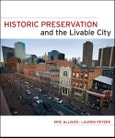Preservation of individual buildings and historic districts is a key ingredient in the success of vibrant and thriving cities. Historic Preservation and the Livable City clearly shows how the preservation of a city′s heritage supports the goals of the livable and sustainable city. The authors demonstrate the many ways in which historic preservation can benefit a community when included as part of a comprehensive planning and economic strategy.
This book covers such issues as:
- Preservation′s contribution to the economy of the livable city
- The economic and environmental benefits of restoring and reusing historic structures
- The link between affordable housing and historic preservation
- The importance of preserving our vernacular architecture and existing building stock
Key features of the book include:
- A livable city checklist for the preparation of proposals and plans for preservation, planning, and urban design projects
- A robust set of illustrated recent examples, including the revitalizations of Lower Downtown (LoDo) in Denver, Colorado, downtown Austin, Texas, and Downtown Eastside in Vancouver, Canada. The examples demonstrate that historic preservation is a key component in developing livable cities
Historic Preservation and the Livable City offers compelling evidence that cities, towns, and rural environments that implement historic preservation actually compete at a higher level economically and are more sustainable. They are more attractive to both prospective and current residents as well as visitors. In a world where cities must attract visitors and residents, historic preservation is an important and often overlooked tool.
Table of Contents
Acknowledgments.Chapter 1: What This Book Is About.
Chapter 2: Using (and Not Using) The Past.
Livable Cities.
What Can Historic Preservation Contribute to This Challenge?
An Historic Preservation Tale of Two Cities.
Is Historic Preservation Legal?
Chapter 3: What Is Historic Preservation?
The People of Historic Preservation.
What Qualifications Do Preservation
Professionals Have?
How Do Preservationists Decide What Should Be Protected?
Who Are We Saving It For?
Haven′t We Saved Enough?
Saving for Everyone.
Chapter 4: The Actors: Community Groups and Governments.
Greenfield Village in Michigan.
The Arthur Ashe Statue in Richmond, Virginia.
The African Burial Ground in Lower New York City.
Participatory Efforts.
Chapter 5: The Actors: Community Groups and Governments Case Study: Station Square, Pittsburgh, Pennsylvania.
Chapter 6: Intersections: How They Work Together.
Denver: Lower Downtown.
What Do Planners Do?
Historic Preservation.
Historic Preservation and Planning.
Neighborhood Conservation Districts.
Form– Based Zoning.
What We Have Here Is a Failure to Coordinate.
Chapter 7 Bringing Them Back from the Malls: Revitalizing Downtown.
Step 1: Capture the Vision.
Step 2: Develop a Strategic Plan.
Step 3: Forge a Healthy Private/Public Partnership.
Step 4: Make the Right Thing Easy.
Step 5: Establish Business Improvement Districts and Other Not– for– Profit Organizations.
Step 6: Create a Catalytic Development Company.
Step 7: Create an Urban Entertainment District.
Step 8: Develop a Rental Housing Market.
Step 9: Pioneer an Affordability Strategy.
Step 10: Focus on For– Sale Housing.
Step 11: Develop a Local– Serving Retail Strategy.
Step 12: Re– Create a Strong Office Market.
Conclusion.
Chapter 8: Bringing Them Back from the Malls: Revitalizing Downtown Case Study: Chattanooga, Tennessee.
Chapter 9: Using the Tools We Have: Urban Planning Tools That Preserve Historic Character.
Zoning.
Comprehensive Plans.
Form– Based Codes.
Affordable Housing.
Planning for Integrated and People– Oriented Spaces.
Chapter 10: Using the Tools We Have: Urban Planning Tools That Preserve Historic Character: Case Study: Dallas, Texas.
Historic Districts and Conservation Districts.
Regulation under the Three– Tier System.
Chapter 11: Neighborhoods for Great Living: Historic Districts.
The Experience of Colonial Williamsburg.
Charleston, South Carolina, Creates an Historic District.
Manchester: Historic Districts for All.
Historic Districts in Livable Cities.
Chapter 12: Neighborhoods for Great Living: Historic Districts Case Study: Manchester, Pennsylvania.
Chapter 13: Sustainable Development and Historic Preservation.
Community Movements.
Preservation as Growth Management.
Reusing Our Existing Buildings.
The Cobb Building, Seattle, Washington.
Waste Management.
The Economics of Sustainability.
The Role of LEED and the U.S. Green Building Council.
Chapter 14: Sustainable Development and Historic Preservation: Case Study: The Cobb Building, Seattle, Washington.
Chapter 15: New Urbanism versus the Livable City.
The New Urbanism Charter.
Ebenezer Howard′s Garden City.
New Urbanism: The New Garden City?
Seaside, Florida.
Facing the Criticism.
Chapter 16: New Urbanism versus the Livable City: Case Study: Radburn, New Jersey.
Chapter 17: The Global Picture.
Rebuilding the Past.
Vancouver: Queen of the Livability Stakes.
Imperial Vienna (Second Place in Global Livability).
Melbourne: Recent Heritage (Third Place in Global Livability).
Preserving Heritage for Livable Cities around the World.
Chapter 18: Afterword.
Endnotes.
Index.








